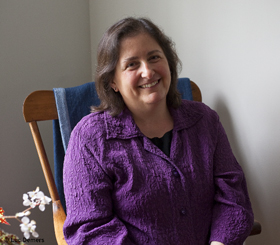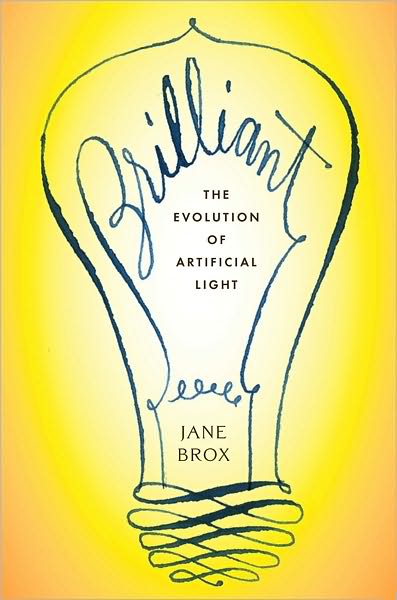 In the following Q&A, contributor J. Luise Eberhardy and author Jane Brox talk about how a writer faces the challenge of reinventing her writing self, and the importance of image and metaphor to connect historical voices with present concerns about artificial light.
In the following Q&A, contributor J. Luise Eberhardy and author Jane Brox talk about how a writer faces the challenge of reinventing her writing self, and the importance of image and metaphor to connect historical voices with present concerns about artificial light.
Time magazine placed Jane Brox’s most recent book, Brilliant: The Evolution of Artificial Light, on its list of Top Ten Nonfiction Books for 2010. Brox is the author of three previous books, including Clearing Land: Legacies of the American; Five Thousand Days Like This One, which was named 1999 finalist for the National Book Critics Circle Award in nonfiction, and Here and Nowhere Else, which won the L.L. Winship/PEN New England Award. Her essays have appeared in many anthologies including The Norton Book of Nature Writing and the Pushcart Prize XXVIII. She is the recipient of grants from the National Endowment for the Arts and the John Simon Guggenheim Foundation.
 *
*
What is Brilliant about?
I think of it as a meditation on the way light changed us as we changed light. That’s not the book I started out to write but, as I worked on it over the years, that’s what the book became.
Brilliant marks a departure from your first three books, which focused on American farm life. Can you talk about this change?
While I was working on my third book, Clearing Land, I knew I’d come to the end of the farm as my subject. I knew in my bones that if I didn’t move on I would have dribbled away as a writer. It was partly a matter of subject, but I also wanted to work more broadly with voice. My first three books interwove the personal story of my life on my family’s farm with the history of place and agriculture. At a very basic level I wanted to see if I could move out of first person narrative and move beyond the subject of the farm at the same time.
When did you first start thinking of Brilliant?
My first thought was to write a book on rural electrification. A lifelong neighbor of mine in Dracut, Massachusetts, who had a nearby farm, told me of the first time he’d lived with electric light. He’d grown up with kerosene lamps, and when he went off to agricultural school in western Massachusetts in the early 1930s, it turns out his boarding house had electricity. When he walked in, he told me, “I just stood there, and I kept switching the light on and off, on and off.” Then he added, “They must have thought I was simple.” It’s his last comment that struck me most forcefully. For the first time I began to glean what modern light meant, that there was a huge gap – socially, economically – between those who had it and those who didn’t.
What prompted you to enlarge your topic?
As I started reading about the history of light–the back story for what I imagined would be my book–I became enchanted with the whole long story of light. At the same time, I was feeling a bit confined by the strict subject of rural electrification. Perhaps it felt too close to my earlier material. Anyway, I think my instincts were telling me where to go. I knew the back story was presenting me with a chance. I can very clearly remember making that decision to move on to the larger subject of light. I’d just moved from the farm to Maine six months before. I had a winter rental along a tidal river–all windows–and I sat there with my piles of books and stared out at the river for most of the day, trying to imagine what a book on light might look like, where it might begin. I sat–and sometimes got up and paced or looked at the material–for the entire day. I felt both challenged and scared. I didn’t necessarily feel I was prepared for such a leap, but I also felt I had to take the chance.
Did you feel the terror of the blank page?
I’m not sure the terror was in the blank page as much as it was in the enormity of the subject and the challenge of how to shape the material. I was often bewildered by the sheer quantity of material, and soon realized I could write a 10,000-page book on light–I could write ten volumes! But I kept returning to the shape of what I imagined the book I wanted to write would be. I didn’t want to write a compendium of information. I didn’t need the book to be comprehensive. I wanted to write a story that would succeed not only as a narrative, but one that would also be connected through image and metaphor.
How did you handle the moments when you asked yourself, is this too much for me?
I just kept the material moving. I often conjured my father–the down-to-earth farmer–who used to say, “stay with it.” Sometimes it was a matter of saying to myself: Here’s the material. Just work on it every day. Just get up and work on it every day. And in the way it happens, the commitment and work would lead to inspiration.
Practically speaking, I gave everything initial attention. For example, I would research whale oil for a few months and write out a rough draft of that chapter, then move on to gaslight or some other large topic. But I always went back into earlier material to build it up, to clarify and expand, so that some of the future would be in the past. The only way I could get a sense of continuity–of both voice and theme–throughout the book was to keep going back over the material.
How did you balance the writing about the way people lived their lives with the scientific development of light?
It always surprises me when Brilliant is talked about as a book on science. I never thought of it that way. Of course, there is a certain amount of technical explanation such as Edison’s history or developments at Niagara Falls but, to me, the story of light is so much more than the science of light. The two, of course, are inextricable, but it was the social and cultural story of light that always led me along. I suppose that goes back to the origins of the book and my neighbor’s comment about electric light.
Did the research provide inspiration?
The research was my inspiration. The experience of light through time is so profoundly different in different ages, and it affects so much of people’s lives–the way they live and work and comprehend the world. I happened upon so many wonderful voices from the past, and the book became, among other things, a chance to bring attention to those very powerful voices from earlier times.
You wanted to carry certain images through to shape the story. Can you talk about why that was so important to you?
Thirty years ago I began writing poetry, and that experience of working with the concentration of language and the patterns and rhythms of poetry is always with me when I write prose. The subject of light itself presented me with countless resonant images. As a writer I felt if I shaped the narrative in a way so as to make those resonances palpable, the work would succeed on another level–for example, the recurring accounts of navigating profoundly dark nights. I tried to make the experience of such nights rhyme with each other, so that there was some commonality between the experience of those trying to walk through the dark whether in the medieval cities, in London during the blitz, in New York City during the 1965 blackout. There were very distinct differences between these historical periods, but I consciously brought in descriptions in the city of London that rhymed with what people in medieval cities would have experienced; in every age they tripped over everyday things such as wood piles and stones. There were resonances of experience, resonances of vision, between one time and the other.
Metaphors can’t be forced, you say. They come in moments of surprise. Can you name one leap, one moment of surprise in the writing of Brilliant?
I suppose the most significant would be the final image of the book, which actually came to me about halfway through the writing. I was well into a stay at the MacDowell Colony, and so I had the space and time to simply spread my work out around me. I was looking at the map of earth at night as seen from space–a composite satellite image–and at the same time I was looking at images of the paintings on the walls of the cave of Lascaux, where the book begins. And all of a sudden I saw in lights of the United States as seen from above, the shape of a creature on the cave wall. The end was in the beginning! I felt as if I had happened upon the metaphor for our human journey, and the image that would tie the book together. No logical process brought me there. Time and patience and concentration may have had something to do with it, but they certainly can’t account for everything. There’s always something inexplicable about metaphor.
Your final chapters focus on the increase of artificial light and environmental concerns. What was your approach?
Our reactions to light are complex, and often irrational. We associate light with our prosperity, with our freedom. I knew I didn’t want the last chapters, which are about the consequences of light pollution, to be instructive in any way. Informative, yes, but not instructive, so I tried to write those last chapters in a way that would give the reader room to meditate. I thought that if I succeeded in telling the story in a compelling way, then people would come to their own conclusions about how they might live with light in our time. I guess that’s any writer’s hope, really: to give the reader an opportunity to have a conversation with the page.
—
J.Luise Eberhardy is currently working on a book, Creating Meaningful Work: What People Do and How It Impacts the World, focused on global activists, artists, and entrepreneurs creating new work for the next generation. Eberhardy is the founding partner of Wiv Inc, a company that strengthens the creative thinking processes in work teams. She teaches writing at Massachusetts College of Art and Design.
